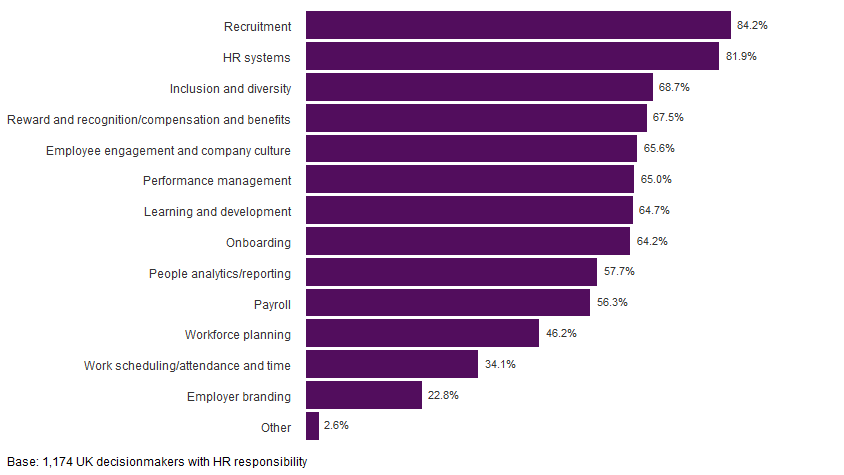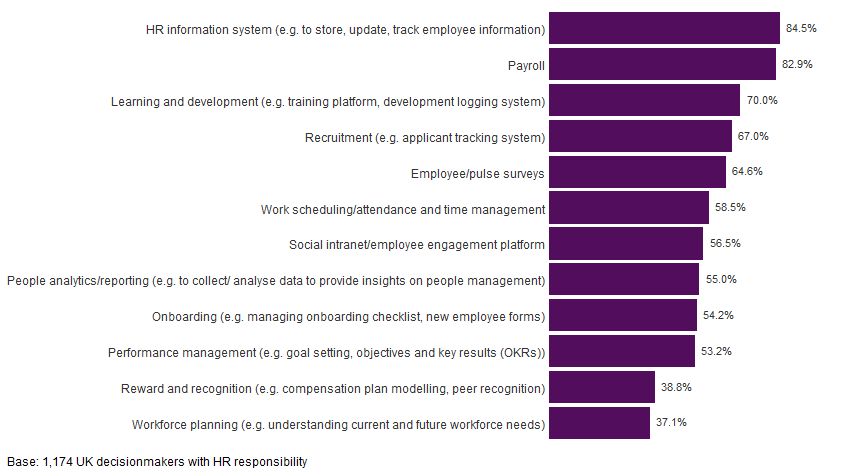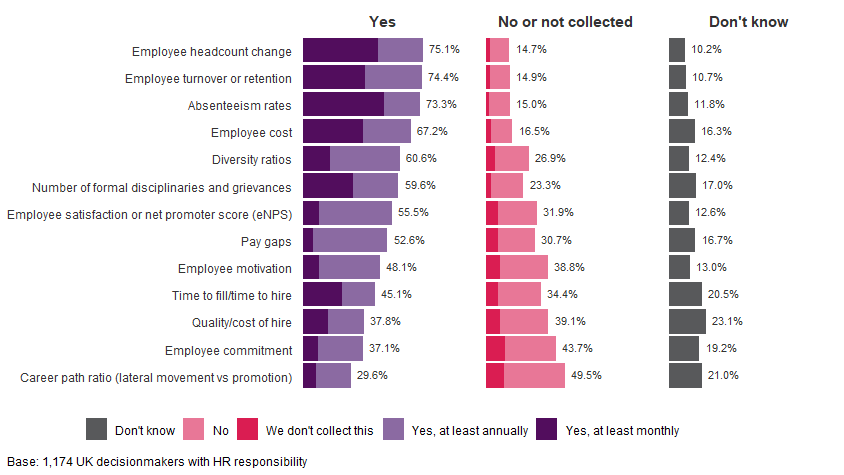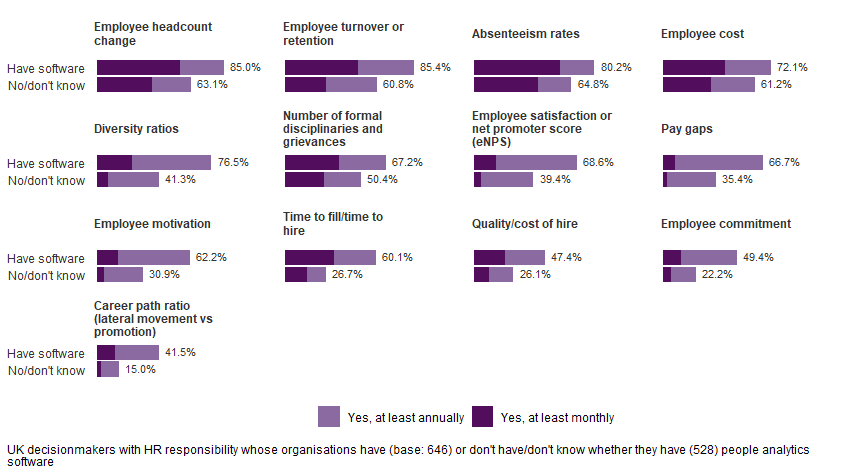Technology and data use in HR functions
Perspectives on what activities fall within HR and how technology and data are used in them (or not)
Perspectives on what activities fall within HR and how technology and data are used in them (or not)
In this article, we outline the findings from the CIPD's survey of 1,174 UK-based HR bosses to shed light on HR’s operating model from a technology and data perspective. Respondents were from organisations with 50 or more employees worldwide – the size we’d expect technology like HR information systems (HRIS) to become crucial for keeping track of employee records.
Recruitment (84.2%) and HR systems (81.9%) were most often cited as matters that are within an HR department’s remit (Figure 1). Other commonly selected choices include inclusion and diversity, reward and recognition, employee engagement, performance management, learning and development and onboarding activities.
Figure 1: Activities the HR department oversees in your organisation

While work scheduling wasn’t so high on the list, our data suggests the activity is more commonly overseen by HR in the manufacturing sector (57.7% vs 34.1% overall). Other less popular areas cited as within HR’s remit included internal communications and events, global mobility and employee relations.
When looking at the figures, it is worth bearing in mind that some of the activities may have seen lower numbers because they are being managed by other departments (for example, finance overseeing payroll) or delegated to people managers. It’s also possible that some respondents might not have been aware of all activities their HR departments oversee.
Here, HR software means any software or platform an organisation uses for HR tasks. This may include programs installed on a work computer or accessed through a web browser.
Figure 2 shows the percentage of HR bosses who said their organisations used certain types of HR software or platforms. Few said they didn’t know whether their organisation had a particular type of HR software – 6% or less for all except reward and recognition (9.5%), people analytics (11.8%) and workforce planning software (12.8%).
Figure 2: HR software or platforms used in your organisation

As expected, most said their organisations have HRIS (84.5%) and payroll software (82.9%). The majority of those who said their organisation didn’t have these came from organisations with 550 or fewer employees worldwide (78.7% and 70% respectively).
In contrast, fewer HR bosses said their organisation used reward and recognition software or platforms (38.8%). These might be used to do compensation plan modelling or facilitate peer-to-peer recognition schemes for example.
Similarly, a smaller proportion said their organisations used HR software or platforms for workforce planning (37.1%). Workforce planning is difficult to do well at scale without a software or platform that enables easy access to good quality data. Indeed, separate research from the CIPD found 46% of people professionals saying their organisation did not collect any data in key areas such as:
Although recruitment (84.2%) was the activity most cited as overseen by HR (Figure 1), not as many HR bosses (67%) said their organisations used recruitment software (Figure 2).
Employee headcount change (net 75.1%), employee turnover or retention (net 74.4%), and absenteeism rates (net 73.3%) were the three metrics that most HR bosses said were reported to management, at least monthly or annually.
In contrast, relatively few said quality or cost of hire, employee commitment, and career path ratio were reported to management (Figure 3). Perhaps this is because these metrics are more difficult to quantify. However, if meaningful definitions can be agreed and the data is relatively easy to collect, then these could also be reported. A good HRIS can support this. For example, the career path ratio is the number of job promotions compared to the number of all movements (lateral and promotions) an employee has had. If all employee role changes are recorded on an HRIS, the career path ratio could be easily calculated and used to track employee career growth in the organisation. This metric could then be used to inform activities to support employee retention and engagement.
Figure 3: Workforce metrics reported to management

The percentage of HR bosses who didn’t know whether certain workforce metrics were reported to management was significant, between 10% and 21%. This is even after we’ve excluded from our analysis those who had no knowledge of what workforce metrics were reported to management at all.
Looking at Figure 4, the findings suggest that workforce metrics were more likely reported to management if the organisation had people analytics software. Reporting was more frequent in organisations with this software than in those without (or without awareness of) the software (compare dark purple bars in Figure 4).
Figure 4: Workforce metrics reported to management - those from organisations who have vs don't have/don't know if they have people analytics software

Having people analytics software can therefore streamline reporting efforts and increase the types of metrics that can be regularly reported to inform management decisions. Modern HRIS typically have a self-service people analytics feature that allows control over who can view relevant key performance indicators (KPIs) and query subsets of the workforce data themselves.
Only 664 of the 1,174 responses we analysed included valid estimates of the number of HR professionals and employees in their organisations worldwide. This is mainly because not everyone knew how many HR professionals their organisations employed.
Of the 664 responses, the median respondent quoted a global HR to employee ratio of 1:60. For the middle 90% of respondents, the global HR to employee ratio ranged between 1:17 and 1:255. Although Table 1 shows a wide spread of ratios, we can see that ratios of 1 HR professional to more than 255 employees are uncommon.
Table 1: Global HR to employee ratio
Base: 664 UK-based HR decisionmakers
While these ratios are interesting, they don’t tell the whole story of HR’s value to different organisations. The ideal HR to employee ratio is one that is optimal for an organisation’s success. Although HR can be responsible for a broad range of activities, our research suggests its most common function is recruitment (Figure 1). Having good people analytics increases the types of workforce metrics and frequency of reporting to support and inform timely decision-making.
In the final article of this series, we’ll delve further into the HR technology that different organisations use and what this means for the people profession.
See our partner Hibob's articles on HR metrics and technology use:
The final article in this series looks at 'Tech savvy' HR practice.
Browse our A–Z catalogue of information, guidance and resources covering all aspects of people practice.
Discover our practice guidance and recommendations to tackle bullying and harassment in the workplace.

Hayfa joined us in 2020. Hayfa has degrees in computer science and human resources from University of York and University of Warwick respectively.
She started her career in the private sector working in IT and then HR and has been writing for the HR community since 2012. Previously she worked for another membership organisation (UCEA) where she expanded the range of pay and workforce benchmarking data available to the higher education HR community.
She is interested in how the people profession can contribute to good work through technology and has written several publications on our behalf, as well as judging our people management awards, speaking at conferences and exhibitions and providing commentary to the media on the subjects of people and technology.


What are the barriers to the adoption of generative AI tools at work and how can they be overcome?

How artificial intelligence (AI), robots and automation are shaping the world of work, the ethical considerations and the role of people professionals.

How can L&D teams create value and impact and improve performance through focusing on skills development?

A summary of the key developments from Ireland’s Budget 2025, focusing on the measures most relevant to the people profession

How can people teams balance line managers’ need for operational people management support while growing their team’s strategic influence through the HRBP role?

We examine and outline recent research investigating the impact of generative AI tools on the HR profession